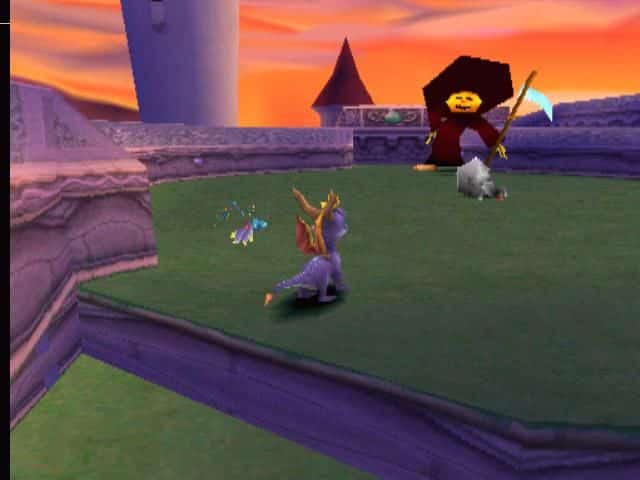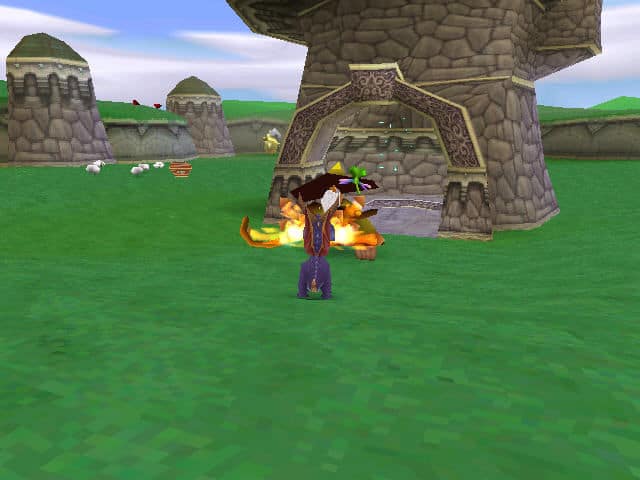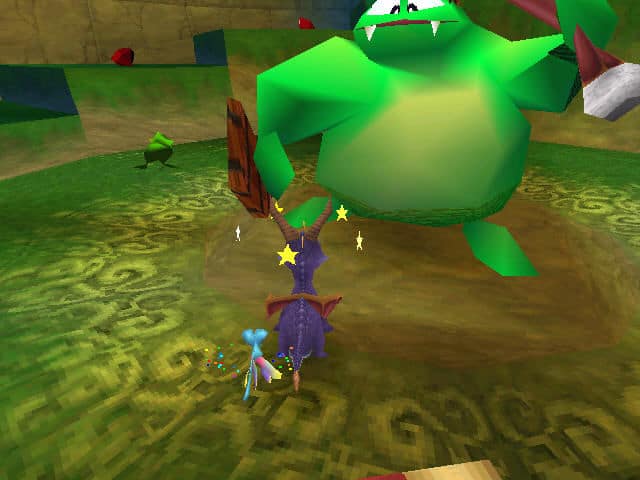Ever since it was announced, the news about 3 of Spyro’s best games being remade has gotten everyone excited. It’s the N’sane Trilogy all over again as we get to see one of the PlayStation’s most beloved platformers finally get the HD treatment. While a lot of people want this to happen, some find it hard to see why they should care.
Think of Spyro as Crash’s rival when it came to the whole 3D platforming collectathon genre. Both had their own unique spin and they both did it really well. Although a lot sided with the orange bandicoot, there were definitely those who enjoyed the tiny purple dragon more.
So let’s get into the first game that introduced us to one of the platformers that dazzled Playstation loyalists.

It begins by showing you a cutscene of the Artisan dragons being interviewed by an unseen crew. It’s not apparent as to why this is happening, but the game expects you to just go with it. As the interview goes on, the dragons take the time to make fun of Gnasty Gnorc—the main villain who’s trying to raise his own army and is described by the dragons as simple-minded and ugly. Hearing this (It was never really explained how as there’s no hint of any viewing devices back then), Gnasty is outraged and casts a spell which encases every dragon in crystal. Although it worked on just about everyone, it failed to affect Spyro due to him not meeting the height and weight requirements to be considered as a threat. And with that, Spyro must take it upon himself to free every dragon and defeat Gnasty Gnorc!
As you can see, the story is very simple. There’s a bad guy, he does something wrong, you beat him up. It’s clear that this game was targetted more towards children, but that didn’t stop teens and adults alike from having fun with it.
Controlling Spyro feels very fluid and using the analog stick to make him move in every direction is great. While you can also go with the D-pad, it’s a lot less precise and not recommended. Our tiny purple dragon has three simple abilities. The first is the ability to breathe fire. Although the range is rather small, it still puts enemies to their knees. Second would be the ability to continuously charge. This is a powerful move as not only does it act as a speed boost that you can access any time, it allows you to knock over certain enemies and break through certain objects or obstacles. And lastly, Spyro can glide over a short distance. Although it would have been cooler to just fly wherever, that wouldn’t make this much of a platformer if you could. But the ability allows you to go over large gaps and explore different areas that would have been impossible otherwise.
Also, Spyro has a health meter in the form of his dragonfly partner, Sparks. Spyro can take at least 4 attacks before dying and every time he’s hit, Sparks color changes to indicate how much health you have left. And how do you replenish health? Simple. You let Sparks eat butterflies that come from random pots or little creatures that you kill. See? Child-friendly game.

There are around 6 worlds that you can traverse and each of them has their own unique levels and challenges. Every environment felt huge and it gave you the sense of freedom that you could never find in games back then. Although there were some that felt a bit too open—especially those that compelled you to run off-screen to your death—, they weren’t really much of a problem.
Each world consists of a hub area where you can access three regular levels, one flight level, and one boss level. And since this game is a collectathon, every world has something for you to find.
First, there are the dragons that you have to save. They’re all encased in crystal and freeing them is as simple as running up towards the statue and giving it a slight poke. They’re scattered throughout the different worlds and all you have to do is find and touch them. Shouldn’t be too hard as you’ll barely miss them.
Then there are the dragon eggs. Since the elders are all busy being trapped inside crystals, some thieves have taken it upon themselves to snatch some dragon eggs for…who knows? There are around 12 in total and you’ll spot them every now and then in different worlds. But once you do, get ready to chase them as they’ll start running around to prevent themselves from getting caught. What’s great is that they taunt you to chase them, making it that much sweeter when you ram or burn them to get the eggs back.
And lastly, there are the gems. These are somewhat of a pain to gather as there are some that will test your ability to search for collectibles. There are even some enemies that you have to get rid of in order to get them. But the good thing is that there’s always the option to check how many gems are left in the world you’re in. This can somewhat help you tell if there’s an area you have yet to check or an enemy you have yet to kill.

Although Spyro can only glide, there are certain levels where he has full access to his ability to fly. These are rightly called the “flight levels” and they’re extremely fun. There are items scattered all throughout these levels and you have a time limit to get them all. Thankfully, items you collect will give you additional time, meaning that there’s an incentive to getting them faster. At the end of every stage, you’re given a rundown on what you’ve collected and the amount of time it took you to collect them all. This was great as you can compare your results with that of your friends and brag if you got everything in less time than they did.
And now let’s head over to the disappointing parts of the game, the boss battles. Although I understand that this was meant for kids, there really should have been more of a challenge when it came to fighting bosses. While all of them look unique, they all have very easy patterns to read. They attack, you evade, you attack and repeat until you win. While the last boss is a bit tough, it’s still not something you should worry about.
Another problem is that there are certain levels where they’re made as if they were meant for you to die. Some have those paths where you feel like you’re allowed to just rush in and charge your way through, only for you to fall into bottomless pits that cause you to lose a life. Thankfully, this problem is mitigated by the fact that lives are never an issue. The only time that you’ll ever have to worry about that is if you’re that inept at simple platforming.
Overall though, this game was a ton of fun and it was definitely one of PlayStation’s most beloved platforming titles. If you haven’t tried it out yet, I suggest that you do. That way, you can compare it with the upcoming trilogy and experience the differences in what was improved on an already a great game.
